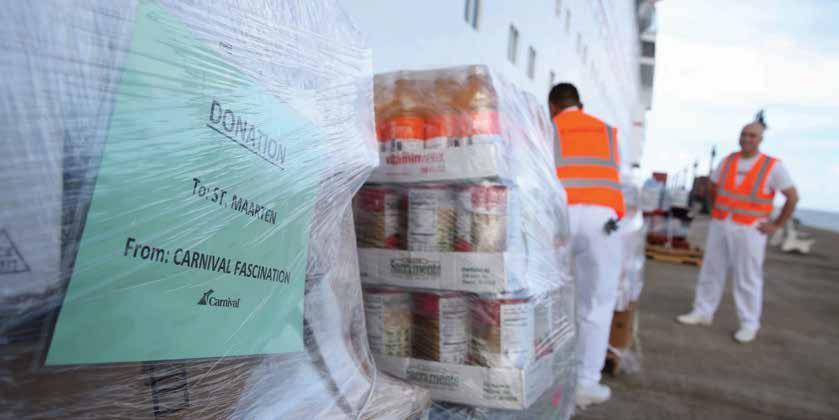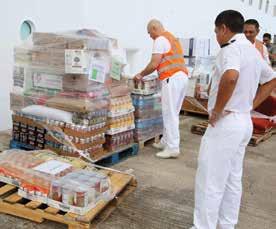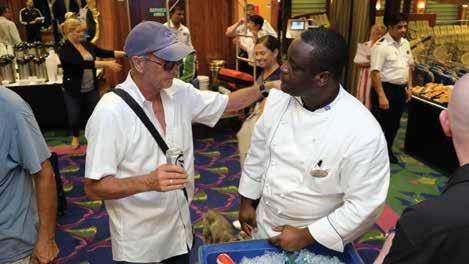
5 minute read
Coming to the Aid of Our Family Following Hurricanes Irma and Maria FCCA President
Coming to the Aid of Our Family Following Hurricanes Irma and Maria
By MICHELE PAIGE, President, Florida-Caribbean Cruise Association (FCCA)
Advertisement
In the wake of Hurricanes Irma and Maria, there was not much that could be said. I wish words could bring back the lost lives, rebuild the catastrophic damage and support people physically and emotionally during that time of need, but there were no words. However, the FCCA and the entire cruise industry took every possible action to help throughout this tragedy.
After all, these are not just our partners, but more like our family. The Caribbean birthed the modern cruise industry, and the destinations and cruise lines have become family in their 50 years together. So it should be no surprise that we were all ready and willing to help bring the family back together.
Even before the storms, FCCA Member Lines were assisting, such as Royal Caribbean Cruises Ltd. (RCCL) providing bottled water, gas and an evacuation option for its employees prior to Irma’s impact. And they—along with Carnival Corporation and Norwegian Cruise Line Holdings brands, MSC Cruises and Disney Cruise Line—were readying plans and ships to provide relief efforts.
After disaster struck, these plans went immediately into action. The FCCA was fortunately able to communicate and work directly with most affected destination partners to ascertain their needs, coming in the form of both evacuation and supplies.
Through this coordination and assistance of destination partners, FCCA Member Lines used their vessels to evacuate or pro vide temporary on board housing for 10,000 stranded visitors and displaced residents.
FCCA Member Lines also used these ships to provide life-saving and -sustaining relief supplies, with more than 40 cruise ships delivering provisions and support, and many removed from revenue cruises to focus on immediate relief.
By the numbers, this represented 30,637 gallons of water, 13,050 pounds of animal supplies, 9,355 gallons of milk, 8,000 pounds of ice, 110,500 garbage bags, 30,504 batteries, 4,200 rolls of toilet paper, 450 power generators and more than 25 pallets of medical supplies—from RCCL alone.
These plans also led to Norwegian Cruise Line delivering 35 pallets of supplies to St. Thomas almost instantly after Irma and Carnival Cruise Line using 11 ships to bring supplies, Disney Cruise Line donating meals and bedding and providing storage for supplies, and MSC Cruises protecting guests in the region during the storms and providing special assistance to those in need, like helping a caregiver in Florida contact her mother in Puerto Rico—all on top the more than $30 million that the cruise industry donated to relief efforts.
Of course, cruise ships could not even reach some impacted destinations, which is why the FCCA worked with its partners to determine needs that could not be fulfilled by the vessels, and then coordinated with its Member Lines for assistance.
To that end, MSC Group answered the call to procure complimentary ship ping of multiple containers of needed goods, free up several large ferries to deliver tons of needed goods and serve as temporary housing, and purchase and provide shipping of a semi-per -
manent school structure for the British Virgin Islands.
That was one of the many semi-permanent structures provided by the FCCA and our partners. After hitting the phones following Irma, we purchased multi-thousand semi-permanent structures for housing and schooling, along with housing pods sleeping six and cots, blankets, mattresses, canned food and other supplies.
We also reached out to more family members, our Platinum Members, with Tropical Shipping complimentarily providing two shipping containers to send supplies where cruise vessels could not reach and Eventstar building the structures at cost and also donating housing pods.
When Maria then delivered an unprecedented back-to-back blow, we and our Member Lines and Platinum Members doubled down. The FCCA again found lines of communications with affected destinations that many could not reach to evaluate their status and needs, while working with other destination partners to find ways to reroute supplies.


Then we immediately expanded our own relief donations by purchasing an additional 1,000 sleeping pods, including cots, mattresses and blankets. In total, the FCCA contributed goods at a value of $780,000 to relief efforts.
We also launched a multifaceted, million-dollar campaign to inject a needed economic boost through tourism by driving awareness that the “Caribbean Is Open,” with more than 1 million square miles and nearly 100 ports and destinations operating unhindered by the storms and ready to welcome visitors, while also displaying the relief efforts of the affected destinations. And that campaign has already generated more than 5 billion impressions, along with a satellite media tour and PSAs from more than 30 celebrities, and shown a measurable improvement of those who will not delay booking or taking a Caribbean vacation.
In fact, it has been so successful that we redirected the campaign to focus on the sunny side of the original messaging, continuing to educate about both the region’s vastness and variety of attractions, activities and cultures—from mountains and waterfalls to forests and deserts and culture and cuisine influenced by the Dutch, French, Spanish, British and a Creole mix of it all—all united by year-round great weather, friendly people and spectacular beaches leading into the Caribbean Sea famous for its crystal-clear, turquoise water.
Of course, we also recognized that relief is just the first step, and that repairing and rebuilding would be necessary for a true return to normalcy for the destinations and economies heavily reliant on cruise tourism.
So we worked to constantly keep communications open to receive all status updates and disseminate them to our Member Lines, while also coordinating with our Member Lines to find out what they needed from des tinations so cruise tourism could return.
That is when the strength and resiliency of the destinations and people were on full display, as the affected destinations worked around the clock to begin repaving the road to normalcy. Many left homes without power, already sweating, to start working long hours so that tourists could enjoy air conditioning and ice cold drinks.
And they did it with the same friendly, welcoming smile that tourists see every day, knowing that their efforts would inject the needed economic boom that tourism represents for their livelihood, with cruise tourism generating a direct economic impact of $3.2 billion, on top of more than 75,000 jobs and $976 million in wage income, in 35 Caribbean and Latin American destinations studied during the 2014-2015 cruise year.
What they might not have known was that they were further displaying the resilience that has become as synonymous with the Caribbean as its iconic turquoise water—and showing that they would not
only return, but come back better than ever.











